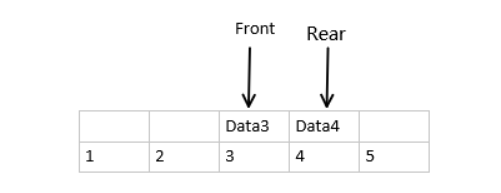什么是循环队列
循环队列就是给定队列的范围,在原有队列的基础上,只要队列的后方满了,就从这个队列的前面开始进行插入,从而达到循环使用队列,由于循环队列本身跟平常的顺序一样,但是其设计思维像一个环,所以经常用一个环图来表示循环队列。
循环队列如下图所示:
[外链图片转存失败,源站可能有防盗链机制,建议将图片保存下来直接上传(img-HlbeQ7rK-1670504084833)(C:\Users\LENOVO\Desktop\屏幕截图 2022-12-08 140831.png)]
循环队列出现的原因
对于队列来说,循环队列出现的原因那是因为顺序队列的假溢出。对于假溢出来说,可以用两个图来解释:


尾指针会随着不断的入队移动到我们可以进行队列操作的范围之外,而前面的存储空间并没有存入任何数据,但队列却出现了溢出的现象,而我们把这种现象称为"假溢出"。
循环队列的结构定义
data表示的是数据域,front和rear指的是队首我队尾。front指针实在出队的时候才会移动,而rear指针则是在入队的时候才会移动。
typedef struct S_queues{
ElemType data[MAXSIZE];
int front;
int rear;
}S_queues,*Queues;
循环队列初始化
Queues Init_Queues(){
Queues q;
q=(Queues) malloc(sizeof(S_queues));
q->front=q->rear=0;
return q;
}
入队操作
对于入队操作,首先要解决的就是怎么来判断堆满的问题,要是想要来判断,而判断的条件则是队尾+1在除最大值是否等于队首。
判断的条件还是由图像来解释显得更加的形象,如图所示:

判断式否队满,需要空出最后一个位置10不用于储存,因为(rear+1)/MAXSIZE,队尾指针加1的情况下如果能满足等于队首指针,等于则队满,如果不等的话,则说明队首指针前进过,可以重新插入数据到前面。
status push(Queues queues,ElemType e){
if((queues->rear+1)%MAXSIZE==queues->front){
printf("队列已满");
return ERROR;
}
queues->rear=(queues->rear+1)%MAXSIZE;
queues->data[queues->rear]=e;
return OK;
}
连续入队操作
Queues M_Insert(Queues queues){
int x;
if(queues==NULL){
return ERROR;
}
while (scanf("%d",&x)!=EOF){
if((queues->rear+1)%MAXSIZE==queues->front){
printf("对列已满");
return ERROR;
}
queues->rear=(queues->rear+1)%MAXSIZE;
queues->data[queues->rear]=x;
}
return queues;
}
出队操作
出队操作和入队操作的其原理式一样的,只不过队列是先入先出,所以,出队的操作是对队首进行操作。
status pop(Queues queues){
if((queues->front+1)%MAXSIZE==queues->rear){
printf("队列为空");
return ERROR;
}
queues->front=(queues->front+1)%MAXSIZE;
return OK;
}
打印队列
void Print_Queues(Queues queues){
if(queues==NULL){
exit(ERROR);
}
int x=queues->front;
while (x!=queues->rear){
x=(x+1)%MAXSIZE;
printf("%d\n",queues->data[x]);
}
}
完整代码
#include "stdlib.h"
#include "stdio.h"
#define OK 1
#define ERROR 0
#define MAXSIZE 100
typedef int status;
typedef int ElemType;
typedef struct S_queues{
ElemType data[MAXSIZE];
int front;
int rear;
}S_queues,*Queues;
///初始化队列
Queues Init_Queues(){
Queues q;
q=(Queues) malloc(sizeof(S_queues));
q->front=q->rear=0;
return q;
}
///连续插入
Queues M_Insert(Queues queues){
int x;
if(queues==NULL){
return ERROR;
}
while (scanf("%d",&x)!=EOF){
if((queues->rear+1)%MAXSIZE==queues->front){
printf("对列已满");
return ERROR;
}
queues->rear=(queues->rear+1)%MAXSIZE;
queues->data[queues->rear]=x;
}
return queues;
}
///入队
status push(Queues queues,ElemType e){
if((queues->rear+1)%MAXSIZE==queues->front){
printf("队列已满");
return ERROR;
}
queues->rear=(queues->rear+1)%MAXSIZE;
queues->data[queues->rear]=e;
return OK;
}
///出队
status pop(Queues queues){
if((queues->front+1)%MAXSIZE==queues->rear){
printf("队列为空");
return ERROR;
}
queues->front=(queues->front+1)%MAXSIZE;
return OK;
}
///遍历打印
void Print_Queues(Queues queues){
if(queues==NULL){
exit(ERROR);
}
int x=queues->front;
while (x!=queues->rear){
x=(x+1)%MAXSIZE;
printf("%d\n",queues->data[x]);
}
}
int main(){
int *d ;
Queues q=Init_Queues();
// push(q,1);
// push(q,2);
q= M_Insert(q);
Print_Queues(q);
pop(q,&d);
printf("删除之后\n");
Print_Queues(q);
printf("出队的值\n");
printf("%d\n",d);
}




















 8981
8981











 被折叠的 条评论
为什么被折叠?
被折叠的 条评论
为什么被折叠?








